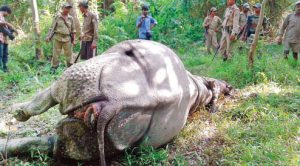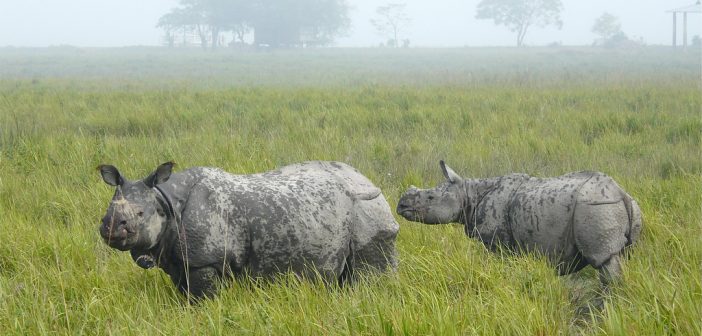(Featured image credit: Rita Willaert, used under CC BY-NC 2.0)
Kaziranga National Park in India, famous for its large population of Great One-horned Rhinoceroses, saw the poaching of yet another rhino this week. This is the second incident reported in this month, in which poachers killed a female rhino and took away her horn. Last week, an adult male rhino was also killed in the park. The poachers killed nine Indian Rhinos this year, raising concerns over negligence from the concerned authorities.
 Kaziranga National Park hosts two-thirds of the world’s Great One-horned Rhinoceroses. The sanctuary is a UNESCO World Heritage Site, located in Assam, towards the east of the subcontinent. The Indian rhinoceros is the second-largest living rhinoceros after the White Rhinoceros, and is found mainly in Kaziranga National Park, Manas National Park and Pabitora Wildlife Sanctuary. After the first half of the twentieth century, rhino population has increased in the country. When the British declared Kaziranga as a game sanctuary in 1916, there were only 20 rhinos left. The small number was the result of relentless hunting of the seemingly dangerous animals. By 1966, the number had gone up to 366. In 1974, the Indian government declared Kaziranga a national park, at which time there were still hardly 500 rhinos. After poaching was made a criminal offence by law, the number of rhinos gradually increased and by 2015, a total of 2,401 Indian rhinoceroses were recorded in the sanctuary.
Kaziranga National Park hosts two-thirds of the world’s Great One-horned Rhinoceroses. The sanctuary is a UNESCO World Heritage Site, located in Assam, towards the east of the subcontinent. The Indian rhinoceros is the second-largest living rhinoceros after the White Rhinoceros, and is found mainly in Kaziranga National Park, Manas National Park and Pabitora Wildlife Sanctuary. After the first half of the twentieth century, rhino population has increased in the country. When the British declared Kaziranga as a game sanctuary in 1916, there were only 20 rhinos left. The small number was the result of relentless hunting of the seemingly dangerous animals. By 1966, the number had gone up to 366. In 1974, the Indian government declared Kaziranga a national park, at which time there were still hardly 500 rhinos. After poaching was made a criminal offence by law, the number of rhinos gradually increased and by 2015, a total of 2,401 Indian rhinoceroses were recorded in the sanctuary.
Though the protection rules are strong, rhinos are widely poached for horn, which is smuggled to other Asian countries for high prices. The poachers collect the horn with local support; the high demand and huge price for rhino horns attract people to join poachers. The global racket provides all facilities like ammunition and electric saws to take the horns. The horns and body parts are used as traditional medicines in countries like Myanmar and Vietnam. “Rhino horn powder, considered an aphrodisiac, is highly valued in Asia and the horns fetch nearly $40,000 a kilogram. It is also used for Asian medicines and for ceremonial purposes.”**
Poaching poses a threat to the Indian Rhino Vision* (IRV) 2020, a partnership among the government of Assam, the International Rhino Foundation and other organizations which aims to attain a population of 3,000 wild rhinos in seven of  Assam’s protected areas by the year 2020. Kaziranga National Park and Pabitora Wildlife Sanctuary currently hold about 75% of the world’s one-horned rhino population. The project helps in repopulating these animals to other protected areas. The threats posed by poachers will negatively affect such rhino repopulation and protection programs.
Assam’s protected areas by the year 2020. Kaziranga National Park and Pabitora Wildlife Sanctuary currently hold about 75% of the world’s one-horned rhino population. The project helps in repopulating these animals to other protected areas. The threats posed by poachers will negatively affect such rhino repopulation and protection programs.
Two months ago a rhino was killed just 30km from where Prince William and Kate Middleton were staying during their Indian visit. The first incident of this month happened during the visit of the forest minister in the sanctuary. The poachers in Kaziranga enter through the Biswanath Chariali area along the northern banks of river Brahmaputra. This cruelty is done by taking advantage of the vast forest cover and ineffective administration. Measures should be taken to protect the animals from poachers, as the recent poaching calls into question the efficiency of rhino conservation in the Country.
__
References:
*Indian Rhino Vision 2020. http://rhinos.org/where-we-work/indian-rhino-vision-2020/
**Subir Bhaumik, Assam rhino poaching ‘spirals’. BBC News, Calcutta. 17 April 2007






1 Comment
It doesn’t make too much sense to me. How do the poachers know if the animal has been injected with the poison. They will still kill them, and just realize later that they cannot use the horns. There has to be another solution
Save the Rhino International’s vision is for all five rhino species to thrive in the wild for future generations. We collaborate with partners to support endangered rhinos in Africa and Asia.
You can stop the slaughter of South Africa’s rhinos …
https://teespring.com/to-save-our-rhinos
ONLY 19$ TO SUPPORT OUR PROGRAM. THANKS FOR YOUR SUPPORTING
To see the our style t-shirt please visit http://www.photoshow.com/watch/cH9hh2pH